The COVID-19 pandemic forced everyone to stay inside their homes, including students and various professionals. Teachers were then faced with a new challenge of teaching from home using video conferencing apps like Zoom, Google Meet, and the like. On the flip side of the coin, it opened up new possibilities that the world had never seen before. People could now come together for a discussion from all around the globe without traveling an inch. I have always been passionate about teaching and thanks to the popularity gained by online classes in the last 2 years, I got several opportunities to teach globally. Throughout this journey, I identified a few crucial things you should consider while teaching online.
Know your platform well
Different organizations have different preferences when it comes to video conferencing applications. Therefore it is always good to familiarize yourself with most of them. Apart from the basics like sharing your screen and choosing a virtual background, it is also good to see where some other complex settings like microphone volume and camera resolution can be found. Sometimes, you might need to assign students to breakout rooms or organize a poll. Therefore, it is important to know these features well in advance. There are several videos on YouTube that might come in handy.
Trigger the five senses
Use animations in your presentations to make them more interactive. Photo courtesy of the author
One of the major drawbacks of teaching online is that you cannot interact with your students directly. They cannot feel your presence. Therefore, quite often students lose their interest midway through your presentation. To overcome this challenge, it is always important to trigger all the five senses of your audience by your words.
Audio: Your voice is the most important asset of the entire presentation. Remember to modulate your voice and pay attention to your tone and intonation.
Visual: Enchant your audience visually with your presentation. Use more pictures and less text. Use some pro strategies like the Rule of three. Also, use animations in your presentation to make it more dynamic. Tools like Canva and Prezi can truly elevate your presentation.
Smell, Taste, and Touch: These are the senses that are very difficult to trigger virtually. But they can make a big difference in the impression you leave on your audience. Use phrases like, “...as soon as Miller and Urey opened the container, a pungent rotten-egg smell filled the room. They had just produced amino acids in-vitro!” Your students will associate the smell with the newly received information. This will leave a long-lasting impression on them.
Engage your audience
Make your audience involved by engaging them in a conversation. Make them smile because a smile goes a mile! Credit: Freepik
Here’s another point to keep in mind. Make sure your audience feels a part of the entire event. They should not be mere listeners. Involve them in your presentation. Make them deduce, discuss, and debate. I find it very powerful to ask students to type something as simple as a + or boom in the chat, to keep them active and involved. Some tools like Padlet and Mentimeter are also great for interacting with your audience in real-time. After the presentation is done, I usually ask a few questions and take feedback from the audience to make them feel valued. Involving them in a quiz or a fun activity is also a powerful strategy.
Finally, the most important tip is to be confident. Do not read out from your notes. Instead, make it feel like a one-on-one conversation.




